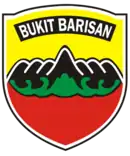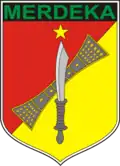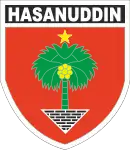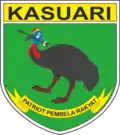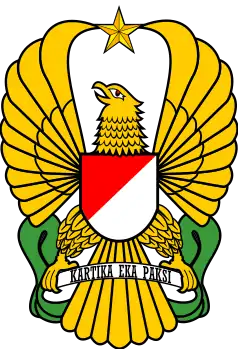Regional Military Command
The Indonesian Military Regional Commands (Indonesian: Komando Daerah Militer abbreviated "Kodam") are military districts of the Indonesian Army which function for territorial defence of various regions within the country. They cover multiple provinces (except for Jakarta which is under one military district command, the Kodam Jayakarta).
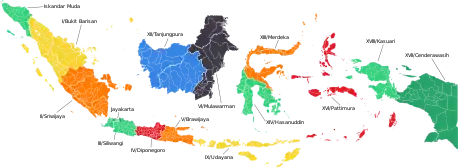
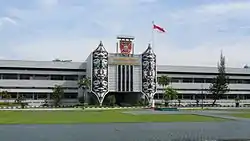
History
The Armed Forces' military regions are known as Kodam. Their organization was established by General Sudirman, following the model of the German Wehrkreise system. The system was later codified in Strategy Order No.1 (Surat Perintah Siasat No.1), signed by General Sudirman in November 1948.[1]
The Army's structure underwent various reorganisations throughout its early years. From 1946 to 1952, the Army was organized into combined arms divisions. These were consolidated in 1951, and then dissolved in 1952. From 1952 to 1958-59, the Army was organised into seven Territorial Armies (Tentara & Teritorium) composed of regiments and independent formations at battalion level and below. In August 1958, the Indonesian Army reconsolidated its territorial organization. This created sixteen regional commands, which retained earlier divisional titles; the Siliwangi Division, for example, became Kodam VI/Siliwangi.[2] The Kodam were subdivided administratively into Areas (the former territorial regiments), Districts (the former regimental battalions) and District Sectors, and operationally composed of a number of speciality battalions and in some regional commands, an infantry brigade.
A reorganisation in 1985 made significant changes in the army chain of command. The four multiservice Regional Defence Commands (Kowilhan) and the National Strategic Forces Command (Kostranas) were eliminated from the defence structure, re-establishing the Military Regional Commands (Kodam) as the key organisation for strategic, tactical, and territorial operations for all services. The 16 regions were reduced to just 10.[3] The chain of command flowed directly from the ABRI commander via the Chief of Staff of the Army to the ten territorial commanders, and then to subordinate army territorial commands. In 1999, the number of regions grew to 10, and today, there are around 15 in active operation.
The territorial commands incorporate provincial and district commands each with infantry battalions, sometimes a cavalry battalion, artillery, or engineers. The number of activated infantry brigades is increasing.[4] Some have Raider battalions attached.
Organization of Regional Commands
Each Regional Command (Kodam) is led by a Major general, assisted by a Chief of Staff who holds the rank of Brigadier General. Kodams oversee several territorial formations under its command, which are:
- Korem or Komando Resor Militer is a territorial army office covering large areas or residencies. They are further divided into two types which are type "A" and type "B". They are commanded by a Brigadier General for type "A" and a Colonel for type "B" respectively. It is below the Kodam and oversee several Kodims
- Kodim or Komando Distrik Militer is a territorial army office covering a City or Regency level. They are further divided into three types which are "independent", type "A" and type "B". They are commanded by a Colonel (for Independent and type "A"), and a Lieutenant Colonel for type "B" respectively. It is below the Korem and oversee several Koramils.
- Koramil or Komando Rayon Militer is a territorial army office covering a sub-district known as Kecamatan. They are further divided into two types, "A" and "B", commanded by a Major for type "A" and a Captain for type "B" respectively. It is below the Kodim and oversee several Babinsa officers.
- Babinsa or Bintara Pembina Desa NCO" is a senior army Non-commissioned Officer (usually holding the rank of
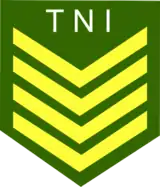 Sergeant Major) or a senior Enlisted rank personnel (usually holding the rank of
Sergeant Major) or a senior Enlisted rank personnel (usually holding the rank of 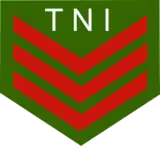 Master corporal) who is in charge for carrying out territorial development and monitoring duties for a community in the village/Kelurahan level.
Master corporal) who is in charge for carrying out territorial development and monitoring duties for a community in the village/Kelurahan level.
- Babinsa or Bintara Pembina Desa NCO" is a senior army Non-commissioned Officer (usually holding the rank of
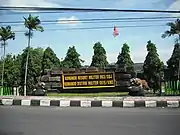 The 063 "Sunan Gunung Jati" Military Area Command (Korem 063) in Cirebon, under Kodam III/Siliwangi
The 063 "Sunan Gunung Jati" Military Area Command (Korem 063) in Cirebon, under Kodam III/Siliwangi.jpg.webp) The 0619 Purwakarta Military District Command (Kodim 0619), under Korem 063
The 0619 Purwakarta Military District Command (Kodim 0619), under Korem 063.jpg.webp) The 2018 Susukan Military Sector Command (Koramil 2018) in Cirebon Regency, under Kodim 0620
The 2018 Susukan Military Sector Command (Koramil 2018) in Cirebon Regency, under Kodim 0620
In addition, each of the Kodams own a Regional Training Regiment (known as Resimen Induk Kodam or Rindam) which is responsible for the training and education of enlisted personnel and non-commissioned officers in their territory.
The office of the Regional Commander is assisted by the following territorial departments:
- Office of the Regional Inspector General (Itdam)
- Office of the Regional Secretariat (Setumdam)
- Regional Military Police Command (Pomdam) - responsible for military law enforcement in the territory
- Regional Public Affairs and Press Office (Pendam) - responsible for public affairs, media and civil-military relations
- Office of the Regional Adjutant General (Ajendam)
- Regional Military Physical Fitness and Sports Office (Jasdam) - responsible for physical fitness and sports affairs
- Regional Medical Department (Kesdam) - responsible for medical affairs
- Regional Veterans and National Reserves Administration (Babiminvetcadam) - responsible for military reserves formation and veterans' affairs
- Regional Topography Service (Topdam)
- Regional Chaplaincy Corps (Bintaldam) - chaplaincy service for personnel who are Muslims, Christians, Hindus, Buddhists and Confucianists
- Regional Finance Office (Kudam) - responsible for financial activities
- Regional Legal Affairs Office (Kumdam)
- Regional HQ and HQ Services Detachment (Detasemen Makodam)
- Regional C3 Unit (Puskodalops Kodam)
- Regional Information and Communications Technology Office (Infolahtadam)
- Regional Logistics and Transportation Division (Bekangdam)
- Regional Signals Division (Hubdam)
- Regional Ordnance Department (Paldam)
- Regional Engineering Division (Zidam)
- Regional Cyber Operations Service (Sandidam)
- Regional Intelligence Command (Deninteldam)
- Liaison offices of the Navy and Air Force formations in each Military Region
Operationally, each "Kodam" is organized as a territorial infantry division which oversee several Subordinate combat units:
- Infantry Brigade
- directly reporting independent Infantry battalions (including Raider Infantry)
- independent Infantry battalions which are under the Military Area Command or "Korem"
- Cavalry Squadron and/or Cavalry Reconnaissance Troop (Separate)
- Field Artillery Battalion/s
- Air Defense Artillery Battalions/Detachments
- Combat Engineers Battalion/s
- Construction Engineers Battalions/Detachments
Military Regions
The following is a list of Military Regional Commands in Indonesia:
References
- Gitiyarko, Vincentinus (1 March 2021). "Serangan Umum 1 Maret 1949". Kompas. Retrieved 29 September 2021.
- Conboy, Kenneth J. (2003). Kopassus: Inside Indonesia's Special Forces. Equinox Publishing. p. 79. ISBN 9789799589880.
- Anderson, Ben (1985). "Current Data on the Indonesian Military Elite". Indonesia. Southeast Asia Program Publications at Cornell University (40): 131–64. JSTOR 3350880.
- "The Military Balance". 106 (1). International Institute for Strategic Studies. 2006.
{{cite journal}}: Cite journal requires|journal=(help)
